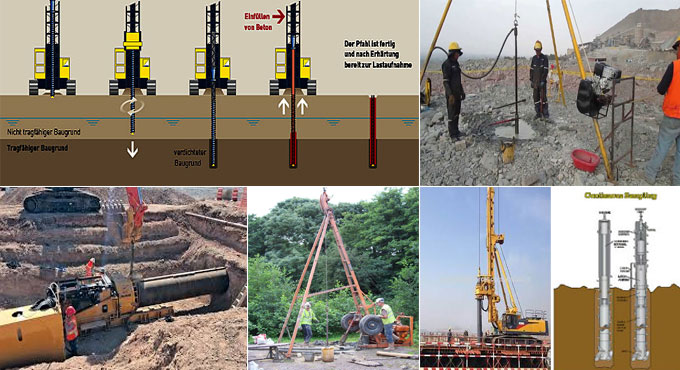
Boring methods of exploration

The boring methods are applied when direct methods can?t work for exploration at deeper depths. On the basis of the method of boring, there are both disturbed and undisturbed samples. While choosing the boring method for a specific job, the following points should be taken into consideration:
a. The materials to be received and the relevant efficiency of the different boring methods in such materials.
b. The accessible facility and the precision with which modifications in the soil and ground water conditions can be set.
c. Feasible disruption of the material to be sampled.
Given below, several types of boring methods:
DISPLACEMENT BORING: It belongs to a combined method of sampling & boring operation. Closed bottom sampler, slit cup, or piston type is pushed into the ground up to the required depth. Then the sampler is removed from soil underneath it, by rotating the piston, & finally the piston is unleashed or withdrawn.
The sampler is then again pushed further down & sample is acquired. After extraction of sampler as well as sample from sampler, the sampler is retained in closed condition & again utilized for another depth.
Features:
a. Simple and inexpensive method if extreme caving is not happened. It can?t be applied for loose sand.
b. Significant modifications of soil character are identified with penetration resistance.
c. They are 25mm to 75mm holes.
d. Fairly continuous sampling in firm and dense soil, either to safeguard the sampler from damage or to get rid of unpleasantly heavy construction pit.
WASH BORING: This method is mostly recognized since limited equipments are employed. Consequently, low-cost and easy portable handling and drilling equipments can be utilized. Initially, an open hole is created on the ground to facilitate the soil sampling or rock drilling operation underneath the hole. The hole is expanded by chopping and twisting action of the light bit. Cutting is performed with forced water and water jet under pressure via the rods working inside the hole.
AUGER BORING: This method is rapid and inexpensive with simple, light, flexible and low-cost instruments for large to small holes. It is very suitable for soft to stiff cohesive soils and also can be used to determine ground water table. Soil detached with this is distressed but it is superior as compared to wash boring, percussion or rotary drilling. This method should not be applied for very hard or cemented soils, very soft soils, since there is possibility for entering the flow into the hole. This method is not recommended for fully saturated cohesionless soil.
ROTARY DRILLING: Rotary drilling method of boring is suitable for extremely resistant strata. It is relevant to determine the rock strata as well as access the quality of rocks from cracks, fissures and joints. It can also be applied in sands and silts also. Here, the depth of the bore holes is extended with rotary percussion method. A heavy string of the drill rod is utilized for choking action. The broken rock or soil fragments are detached with circulating water or drilling mud pumped via the drill rods and bit up via the bore hole from which it is compiled in a settling tank for recirculation. If the depth is small and the soil is stable, water alone can be applied. The drilling fluids play an important role since as they help in stabilizing the bore hole.
PERCUSSION DRILLING: For hard soils or soft rock, auger boring or wash boring are not recommended. For such strata, percussion drilling is mostly used. Here, the hole is expanded by alternatively lifting and dropping a heavy drilling bit which is connected with the lower end of the drilling bit and it is connected with the cable. Once the soil attains it?s bearing strength, churn bit and the slurry are detached with bailers and sand pumps. Modification in soil character is recognized with the composition of the outgoing slurry.
CONTINUOUS SAMPLING: The sampling operation progresses the borehole and the boring is done completely by obtaining samples constantly. To resist the caving in soils, the casing is applied. This method is useful to obtain trustworthy and detail information on soil condition as compared to the other methods. So, it is frequently utilized in detailed and special foundation exploration for vital structures.
Source: https://civilblog.org


